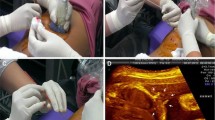Abstract
Background
Adequate visualization of the placenta or umbilical cord during fetoscopic procedures in complicated monochorionic twin pregnancies may be difficult because of placental position and spatial constraints, as well as stained amniotic fluid. Partial amniotic carbon dioxide insufflation (PACI) has made it possible to overcome these obstacles in other fetoscopic procedures, but its value has not yet been reported in monochorionic twins.
Methods
Partial amniotic carbon dioxide insufflation was carried out in five expectant women with complicated monochorionic twin pregnancies between 19 + 6 to 29 + 4 weeks of gestation when adequate fetoscopic visualization of pathological placental surface vessels or the umbilical cord was impossible because of stained or too little amniotic fluid. In four cases, five fetoscopic laser ablations of pathological placental vessels in twin-to-twin transfusion syndrome (TTTS) were performed. In one discordant twin pregnancy with TTTS, PACI was carried out in order to achieve umbilical cord ligation in a recipient with omphalocele and cardiac malformation.
Results
Partial amniotic carbon dioxide insufflation offered superior visualization and did not result in any acute maternal or fetal complications. After fetoscopic laser coagulation, three women delivered one fetus at 27 + 5, two fetuses at 28 + 6, and two fetuses at 35 + 4 weeks of gestation, respectively. One set of twins with TTTS was lost. Following umbilical cord ligation, the surviving twin was delivered at 37 + 2 weeks of gestation.
Conclusions
Partial amniotic carbon dioxide insufflation may facilitate fetoscopic procedures in complicated monochorionic twin pregnancies when conventional fetoscopic approaches within amniotic fluid meet difficulties. Further studies are required to allow assessment of benefits, risks, and safety margins of the new approach before it can generally be recommended.



Similar content being viewed by others
References
Bruner JP, Richards WO, Tulipan NB, Arney TL (1999) Endoscopic coverage of fetal myelomeningocele in utero. Am J Obstet Gynecol 180(Pt 1): 153–158
Gratacos E, Wu J, Devlieger R, Van de Velde M, Deprest JA (2001) Effects of amniodistension with carbon dioxide on fetal acid-base status during fetoscopic surgery in the sheep model. Surg Endosc 15: 368–372
Kohl T, Hering R, Van de Vondel P, Tchatcheva K, Berg C, Bartmann P, Heep A, Franz A, Müller A, Gembruch U (2006) Analysis of the step-wise clinical introduction of experimental percutaneous fetoscopic surgical techniques for upcoming minimally-invasive fetal cardiac interventions. Surg Endosc 20: 1134–1143
Luks FI, Deprest JA, Marcus M, Vandenberghe K, Vertommen JD, Lerut T, Brosens I (1994) Carbon dioxide pneumamniosis causes acidosis in fetal lambs. Fetal Diagn Ther 9: 105–109
Sayki Y, Litwin DE, Bigras JL, Waddel J, Konig A, Baik S, Navsarikar A, Rebeyka IM (1997) Reducing the deleterious effects of intrauterine Co2 during fetoscopic surgery. J Surg Res 69: 51–54
Acknowledgments
We are particularly grateful to Ms. Sybill Storz of Karl Storz GmbH, Tuttlingen, Germany, who provided the entire fetoscopic equipment for the underlying experimental work in sheep that allowed clinical introduction of the amniotic insufflation technique in complicated monochorionic twin pregnancies.
Author information
Authors and Affiliations
Corresponding author
Rights and permissions
About this article
Cite this article
Kohl, T., Tchatcheva, K., Berg, C. et al. Partial amniotic carbon dioxide insufflation (PACI) facilitates fetoscopic interventions in complicated monochorionic twin pregnancies. Surg Endosc 21, 1428–1433 (2007). https://doi.org/10.1007/s00464-006-9183-7
Received:
Revised:
Accepted:
Published:
Issue Date:
DOI: https://doi.org/10.1007/s00464-006-9183-7




